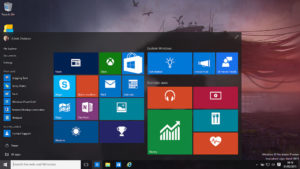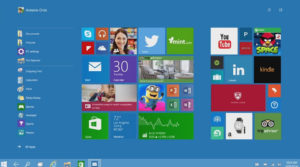In 2014, Microsoft announced their latest operating system. Even though their current version was known as Windows 8, Microsoft chose not to call the new version Windows 9; they skipped straight to Windows 10. The reason for skipping Windows 9 was never made clear, but most experts agree that Microsoft hopes to distance themselves from Windows 8, which was never popular with consumers or business users.
Windows 10 was officially unveiled during a media event on September 30th of 2014. Right from the start, Microsoft emphasized how much different and better Windows 10 would be. The eventual goal was to have a single operating system running on platforms from computerized appliances to the Xbox. The official consumer release came on July 29, 2015. In an unusual twist, Microsoft chose to offer a free upgrade to Windows 10 for existing users of Windows 7 or Windows 8. This led to a widespread adoption of the new operating system. The free upgrade offer ended on July 29, 2016. Now, users must pay anywhere from $100 – $200 depending on which version of Windows 10 they choose.
Windows 10 introduced significant changes to the way users interact with their computers.
Some of the most significant new Windows 10 features are:
 Touchscreen Optimized Interface
Touchscreen Optimized Interface
Many people are familiar with using smartphones and tablets; Windows 10 has a touchscreen-optimized interface designed to be immediately usable by consumers of all levels of experience.
Virtual Desktop System
Users can choose to use multiple, virtual desktops to improve their workflow. This has been available on operating systems like Unix and Linux, but was a novel development for a consumer-grade operating system.
Biometric Login
Windows 10 offers users the ability to log in using facial recognition or fingerprint scanning. This could potentially improve security.
These features debuted with mixed results and reviews. Regardless of their popularity, these key features are central to the Windows 10 experience.
Operating System as a Service
For Windows 10, Microsoft is moving to a subscription-based model. Rather than purchasing the software outright, customers purchase a license to use the operating system. Microsoft planned to release regular, incremental updates to improve security and fix bugs as they are discovered. For enterprise users, Microsoft offers a different upgrade schedule. These customers can choose to receive only critical updates.
The ultimate goal of the new model is to reduce fragmentation. Rather than supporting multiple versions of Windows, Microsoft hopes to have every user on Windows 10. So far, Microsoft has made significant steps toward this goal.
Windows 10 has been quite successful since its release. By January of 2016, Windows 10 was running on more than 200 million devices. The rate of Windows 10 adoption was also far higher than for any other version. Windows 10 grew at nearly 4 times the growth rate of Windows 8. By the end of 2016, more than 400 million devices.
Other Versions of Windows
Many business and home users are still using older versions of Windows. Microsoft ended support for Windows XP on April 8, 2014. The official support for Windows Vista will end on April 11, 2017. Support for Windows 7 and Windows 8 is scheduled to extend to 2020 and 2023 respectively.
Neither Windows XP or Vista are well suited for enterprise users; while Windows 7 and 8 may still be viable choices, there are advantages to using Windows 10.
Windows 10 Updates
 One of the major features of Windows 10 is the compressed timetable for updates. This alone may be reason enough for many enterprise customers to upgrade their computer systems. However, no piece of software is perfect. Just like any other operating system, Windows 10 has benefits and drawbacks for enterprise customers:
One of the major features of Windows 10 is the compressed timetable for updates. This alone may be reason enough for many enterprise customers to upgrade their computer systems. However, no piece of software is perfect. Just like any other operating system, Windows 10 has benefits and drawbacks for enterprise customers:
Rapid Updates May Improve Security
Windows 10 has a much faster upgrade schedule than any previous version of Windows. This means that many security vulnerabilities and other bugs have a chance to be fixed before they can be widely exploited. However, keeping a large number of computers patched and updated could be a significant challenge, especially in a large enterprise.
Windows 10 Has Long-Term Viability
Windows 10 Support is scheduled to last through at least 2025. This means that IT managers of today can be confident that the computer systems they purchase today will enjoy continued support through their entire life cycle.
Unfamiliar Operating System
Many users do not care for the Windows 10 user interface. Though there are tools available that quite accurately emulate and experience familiar to long-time Microsoft Windows users, adding software to fundamentally change the operating system introduces security concerns.
Windows Phone Integration
Windows 10 was designed to work well with the Windows Phone. Unfortunately, the Windows Phone platform is not nearly as popular as the PC operating system. Fewer than 1% of smartphone users choose Windows Phone devices. Despite the enormous range of choice in the smartphone market, the Apple iPhone continues to dominate. Many tech workers are bringing their own devices to work; these workers may want computers that can work closely with their handheld devices.
Should You Upgrade?
When Windows 10 was free, the decision to upgrade was easy for many users. If your computer was running Windows 8, Windows 10 promised to be a dramatic improvement. For Windows 7 users, the decision was a bit more complicated. For these users, the decision was governed by their hardware. Computers that could run the new operating system could often benefit from the new features and updated security.
Today, for most users there is no compelling reason to upgrade to Windows 10. However, for any consumer or enterprise purchasing new computers Windows 10 is the best choice among the versions of Windows available.
Since its release in 2015, Windows 10 has steadily gained market share and penetration. Microsoft hopes to eventually have 1 billion users systems running Windows 10. Since Microsoft Windows is the most popular operating system in existence by far, this goal will likely become a reality in time.
Windows hopes to launch in 2017 an updated design interface to Windows 10, named Project NEON.
Posted by